Biocatalyzed Redox Processes Employing Green Reaction Media
Abstract
:1. Introduction
2. Biocatalyzed Redox Processes at Neat Conditions
3. Application of Bio-Based Solvents in Redox Reactions Catalyzed by Enzymes
4. Deep-Eutectic Solvents in Bioreductions/Biooxidations
4.1. Bioreductions in Presence of (NA)DESs
4.2. Application of DES in Biooxidations
5. Conclusions and Future Perspectives
Author Contributions
Funding
Conflicts of Interest
References
- Hudlicky, T.; Reed, J.W. Applications of biotransformations and biocatalysis to complexity generation in organic synthesis. Chem. Soc. Rev. 2009, 38, 3117–3132. [Google Scholar] [CrossRef] [PubMed]
- Sheldon, R.A.; Brady, D. Broadening the scope of biocatalysis in sustainable organic synthesis. ChemSusChem 2019, 12, 2859–2881. [Google Scholar] [CrossRef] [PubMed]
- Sheldon, R.A.; Woodley, J.M. Role of biocatalysis in sustainable chemistry. Chem. Rev. 2018, 118, 801–838. [Google Scholar] [CrossRef] [PubMed]
- Dominguez de María, P.; de Gonzalo, G.; Alcántara, A.R. Biocatalysis as useful tool in asymmetric synthesis: An assessment of recently granted patents (2014–2019). Catalysts 2019, 9, 802. [Google Scholar] [CrossRef] [Green Version]
- Sheldon, R.A.; Brady, D. The limits to biocatalysis: Pushing the envelope. Chem. Commun. 2018, 54, 6088–6144. [Google Scholar] [CrossRef] [PubMed]
- Domínguez de María, P.; de Gonzalo, G. (Eds.) Biocatalysis: An Industrial Perspective, 1st ed.; Royal Society of Chemistry: Cambridge, UK, 2018. [Google Scholar]
- Patel, R.N. Biocatalysis for the synthesis of pharmaceuticals. Bioorganic Med. Chem. 2018, 26, 1252–1274. [Google Scholar] [CrossRef] [PubMed]
- Hollmann, F.; Opperman, D.J.; Paul, C.E. Enzymatic reductions: A chemist’s perspective. Angew. Chem. Int. Ed. 2020. [Google Scholar] [CrossRef]
- De Gonzalo, G.; Lavandera, I. Recent advances in selective biocatalytic (hydrogen transfer) reductions. In Homogeneous Hydrogenation with Non-Precious-Catalysts, 1st ed.; Teichert, J.F., Ed.; Wiley-VCH: Weinheim, Germany, 2020; pp. 227–259. [Google Scholar]
- Dong, J.J.; Fernández-Fueyo, E.; Hollmann, F.; Paul, C.E.; Pesic, M.; Schmidt, S.; Wang, Y.H.; Younes, S.; Zhang, W.Y. Biocatalytic oxidation reactions: A chemist’s perspective. Angew. Chem. Int. Ed. 2018, 57, 9238–9261. [Google Scholar] [CrossRef]
- Holtmann, D.; Fraaije, M.W.; Arends, I.W.C.E.; Opperman, D.J.; Hollmann, F. The taming of oxygen: Biocatalytic oxyfunctionalizations. Chem. Commun. 2014, 50, 13180–13200. [Google Scholar] [CrossRef] [Green Version]
- Domínguez de María, P.; Hollmann, F. On the (un)greenness of biocatalysis: Some challenging figures and some promising options. Front. Microbiol. 2016, 6, 1257. [Google Scholar] [CrossRef] [Green Version]
- Zaks, A.; Klibanov, A.M. Enzymatic catalysis in nonaqueous solvents. J. Biol. Chem. 1988, 263, 3194–3201. [Google Scholar] [PubMed]
- Zaks, A.; Klibanov, A.M. Enzyme-catalyzed processes in organic solvents. Proc. Natl. Acad. Sci. USA 1985, 82, 3192–3196. [Google Scholar] [CrossRef] [PubMed] [Green Version]
- Carrea, G.; Riva, S. Properties and synthetic applications of enzymes in organic solvents. Angew. Chem. Int. Ed. Engl. 2000, 39, 2226–2254. [Google Scholar] [CrossRef]
- Hernáiz, M.J.; Alcántara, A.R.; García, J.I.; Sinisterra, J.V. Applied biotransformations in green solvents. Chem. Eur. J. 2010, 16, 9422–9437. [Google Scholar] [CrossRef]
- Sheldon, R.A. The E factor 25 years on: The rise of green chemistry and sustainability. Green Chem. 2017, 19, 18–43. [Google Scholar] [CrossRef]
- Pace, V.; Hoyos, P.; Castoldi, L.; Domínguez de María, P.; Alcántara, A.R. 2-Methyltetrahydrofuran (2-MeTHF): A biomass-derived solvent with broad application in organic chemistry. ChemSusChem 2012, 5, 1369–1379. [Google Scholar] [CrossRef]
- De Gonzalo, G.; Alcántara, A.R.; Domínguez de María, P. Cyclopentyl methyl ether (CPME): A versatile eco-friendly solvent for applications in biotechnology and biorefineries. ChemSusChem 2019, 12, 2083–2097. [Google Scholar] [CrossRef]
- Clarke, C.J.; Tu, W.C.; Levers, O.; Bröhl, A.; Hallet, J.P. Green and sustainable solvents in chemical processes. Chem. Rev. 2018, 118, 747–800. [Google Scholar] [CrossRef]
- Calvo-Flores, F.G.; Monteagudo-Arrebola, M.J.; Dobado, J.A.; Isac-García, J. Green and bio-based solvents. Top. Curr. Chem. 2018, 376, 18. [Google Scholar] [CrossRef]
- Guajardo, N.; Domínguez de María, P. Assessing biocatalysis using dihydrolevoglucosenone (Cyrene™) as versatile bio-based (co)solvent. Mol. Catal. 2020, 485, 110813. [Google Scholar] [CrossRef]
- Hoang, H.N.; Matsuda, T. Expanding substrate scope of lipase-catalyzed transesterification by the utilization of liquid carbon dioxide. Tetrahedron 2016, 72, 7229–7234. [Google Scholar] [CrossRef]
- Matsuda, T. Recent progress in biocatalysis using supercritical carbon dioxide. J. Biosci. Bioeng. 2013, 115, 233–241. [Google Scholar] [CrossRef] [PubMed]
- Cantone, S.; Hanefeld, U.; Basso, A. Biocatalysis in non-conventional media—Ionic liquids, supercritical fluids and the gas phase. Green Chem. 2007, 9, 954–971. [Google Scholar] [CrossRef]
- Hoang, H.N.; Nagashima, Y.; Mori, S.; Kagechika, H.; Matsuda, T. CO2-expanded bio-based liquids as novel solvents for enantioselective biocatalysis. Tetrahedron 2017, 73, 2984–2989. [Google Scholar] [CrossRef]
- Itoh, T. Ionic liquids as tool to improve enzymatic organic synthesis. Chem. Rev. 2017, 117, 10567–11607. [Google Scholar] [CrossRef]
- Lozano, P.; Alvárez, E.; Bernal, J.M.; Nieto, S.; Gómez, C.; Sánchez-Gómez, G. Ionic liquids for clean biocatalytic processes. Curr. Green Chem. 2017, 4, 116–129. [Google Scholar] [CrossRef]
- Domínguez de María, P. (Ed.) Ionic Liquids in Biotransformations and Organocatalysis, 1st ed.; John Wiley & Sons: Hoboken, NJ, USA, 2012. [Google Scholar]
- Domínguez de María, P.; Maugeri, Z. Ionic liquids in biotransformations: From proof of concept to emerging deep-eutectic-solvents. Curr. Opin. Chem. Biol. 2011, 15, 220–225. [Google Scholar] [CrossRef]
- Mbous, Y.P.; Hayyan, M.; Hayyan, A.; Wong, W.F.; Hashim, M.A.; Looi, C.Y. Applications of deep eutectic solvents in biotechnology and bioengineering—Promises and challenges. Biotechnol. Adv. 2017, 35, 105–134. [Google Scholar] [CrossRef]
- Smith, E.L.; Abbott, A.P.; Ryder, K.S. Deep eutectic solvents (DESs) and their applications. Chem. Rev. 2014, 114, 11060–11082. [Google Scholar] [CrossRef] [Green Version]
- Zhang, Q.H.; Vigier, K.D.; Royer, S.; Jerome, F. Deep eutectic solvents: Syntheses, properties and applications. Chem. Soc. Rev. 2012, 41, 7108–7146. [Google Scholar] [CrossRef]
- Heeres, A.; Vanbroekhoven, K.; Van Hecke, W. Solvent-free lipase-catalyzed production of (meth) acrylate monomers: Experimental results and kinetic modeling. Biochem. Eng. J. 2019, 142, 162–169. [Google Scholar] [CrossRef]
- Wunschik, D.S.; Ingenbosch, K.N.; Zähres, M.; Horst, J.; Mayer, C.; Jäger, M.; Strehmel, V.; Dornbusch, M.; Hoffmann-Jacobsen, K. Biocatalytic and solvent-free synthesis of a bio-based biscyclocarbonate. Green Chem. 2018, 20, 4738–4745. [Google Scholar] [CrossRef]
- Böhmer, W.; Koenekoop, L.; Simon, T.; Mutti, F. Parallel Interconnected Kinetic Asymmetric Transformation (PIKAT) with an immobilized ω-transaminase in neat organic solvent. Molecules 2020, 25, 2140. [Google Scholar] [CrossRef] [PubMed]
- Hobbs, H.R.; Thomas, N.R. Biocatalysis in supercritical fluids, fluorous solvents and under solvent-free conditions. Chem. Rev. 2007, 107, 2786–2820. [Google Scholar] [CrossRef] [PubMed]
- Kara, S.; Spickermann, D.; Weckbecker, A.; Leggewie, C.; Arends, I.W.C.E.; Hollmann, F. Bioreductions catalyzed by an alcohol dehydrogenase in non-aqueous media. ChemCatChem 2014, 6, 973–976. [Google Scholar] [CrossRef]
- Zheng, Y.-G.; Yin, H.-H.; Yu, D.-F.; Chen, X.; Tang, X.-L.; Zhang, X.-J.; Xue, Y.-P.; Wang, Y.-J.; Liu, Z.-Q. Recent advances in biotechnological applications of alcohol dehydrogenases. Appl. Microbiol. Biotechnol. 2017, 101, 987–1001. [Google Scholar] [CrossRef]
- Moody, T.S.; Rozzell, J.D. Modern biocatalytic ketone reduction. In Organic Synthesis Using Biocatalysts; Goswami, A., Stewart, J., Eds.; Elsevier: Amsterdam, The Netherlands, 2016; pp. 149–186. [Google Scholar]
- Nealon, C.M.; Musa, M.M.; Patel, J.M.; Phillips, R.S. Controlling substrate specificity and stereospecificity of alcohol dehydrogenases. ACS Catal. 2015, 5, 2100–2114. [Google Scholar] [CrossRef]
- De Gonzalo, G.; Lavandera, I.; Faber, K.; Kroutil, W. Enzymatic reduction of ketones in “micro-aqueous” media catalyzed by ADH-a from Rhodococcus ruber. Org. Lett. 2007, 9, 2163–2166. [Google Scholar] [CrossRef]
- Jakoblinnert, A.; Mladenov, R.; Paul, A.; Sibilla, F.; Schwaneberg, U.; Ansorge-Schumacher, M.B.; Domínguez de María, P. Asymmetric reduction of ketones with recombinant E. coli whole cells in neat substrates. Chem. Commun. 2011, 47, 12230–12232. [Google Scholar] [CrossRef] [Green Version]
- Erdmann, V.; Mackfeld, U.; Rother, D.; Jakoblinnert, A. Enantioselective, continuous (R)- and (S)-2-butanol synthesis: Achieving high space-time yields with recombinant E. coli cells in a micro-aqueous, solvent-free reaction system. J. Biotechnol. 2014, 191, 106–112. [Google Scholar] [CrossRef]
- Hibino, A.; Ohtake, H. Use of hydrophobic bacterium Rhodococcus rhodochrous NBRC15564 expressed thermophilic alcohol dehydrogenases as whole-cell catalyst in solvent-free organic media. Process Biochem. 2013, 48, 838–843. [Google Scholar] [CrossRef]
- Fernández-Fueyo, E.; Ni, Y.; Gomez Baraibar, A.; Alcalde, M.; van Langen, L.M.; Hollmann, F. Towards preparative peroxygenase-catalyzed oxyfunctionalization reactions in organic media. J. Mol. Catal. B Enzym. 2016, 134, 347–352. [Google Scholar] [CrossRef] [Green Version]
- Rauch, M.C.R.; Tieves, F.; Paul, C.E.; Arends, I.W.C.E.; Alcalde, M.; Hollmann, F. Peroxygenase-catalysed epoxidation of styrene derivatives in neat reaction media. ChemCatChem 2019, 11, 4519–4523. [Google Scholar] [CrossRef] [PubMed] [Green Version]
- Hofrichter, M.; Kellner, H.; Herzog, R.; Karich, A.; Liers, C.; Scheibner, K.; Wambui, V.; Ullrich, R. Fungal peroxygenases: A phylogenetically old superfamily of heme enzymes with promiscuity for oxygen transfer reaction. In Grand Challenges in Fungal Biotechnology; Nevalainen, H., Ed.; Springer: Cham, Switzerland, 2020. [Google Scholar]
- Wang, Y.; Lan, D.; Durrani, R.; Hollmann, F. Peroxygenases en route to becoming dream catalysts. What are the opportunities and challenges? Curr. Opin. Chem. Biol. 2017, 37, 1–9. [Google Scholar] [CrossRef] [PubMed]
- Tieves, F.; Willot, S.J.P.; van Schi, M.M.C.H.; Rauch, M.C.R.; Younes, S.H.H.; Zhang, W.; Dong, J.; Gomez de Santos, P.; Robbins, J.M.; Bommarius, B.; et al. Formate Oxidase (FOx) from Aspergillus oryzae: One catalyst enables diverse H2O2-dependent biocatalytic oxidation reactions. Angew. Chem. Int. Ed. 2019, 58, 7873–7877. [Google Scholar] [CrossRef] [PubMed] [Green Version]
- Freakley, S.J.; Kochius, S.; van Marwijk, J.; Fenner, C.; Lewis, R.J.; Baldenius, K.; Marais, S.S.; Opperman, D.J.; Harrison, S.T.L.; Alcalde, M.; et al. A chemo-enzymatic oxidation cascade to activate C–H bonds with in situ generated H2O2. Nat. Commun. 2019, 10, 4178. [Google Scholar] [CrossRef]
- Azzena, U.; Carraro, M.; Pisano, L.; Monticelli, S.; Bartolotta, R.; Pace, V. Cyclopentyl methyl ether: An elective ecofriendly solvent in classical and modern chemistry. ChemSusChem 2019, 12, 40–70. [Google Scholar] [CrossRef] [PubMed] [Green Version]
- Reß, T.; Hummel, W.; Hanlon, S.P.; Iding, H.; Gröger, H. The organic–synthetic potential of recombinant ene reductases: Substrate-scope evaluation and process optimization. ChemCatChem 2015, 7, 1302–1311. [Google Scholar] [CrossRef]
- Toogood, H.S.; Scrutton, N.S. Discovery, characterization, engineering, and applications of ene-reductases for industrial biocatalysis. ACS Catal. 2018, 8, 3532–3549. [Google Scholar] [CrossRef]
- Winkler, C.K.; Faber, K.; Hall, M. Biocatalytic reduction of activated CC-bonds and beyond: Emerging trends. Curr. Opin. Chem. Biol. 2018, 43, 97–105. [Google Scholar] [CrossRef]
- Mangas-Sanchez, J.; France, S.P.; Montgomery, S.L.; Aleku, G.A.; Man, H.; Sharma, M.; Ramsden, J.I.; Grogan, G.; Turner, N.J. Imine reductases (IREDs). Curr. Opin. Chem. Biol. 2017, 37, 19–25. [Google Scholar] [CrossRef] [PubMed]
- Grogan, G.; Turner, N.J. InspIRED by nature: NADPH-dependent imine reductases (IREDs) as catalysts for the preparation of chiral amines. Chem. Eur. J. 2016, 22, 1900–1907. [Google Scholar] [CrossRef] [PubMed]
- Maugeri, Z.; Rother, D. Application of imine reductases (IREDs) in micro-aqueous reaction systems. Adv. Synth. Catal. 2016, 358, 2745–2750. [Google Scholar] [CrossRef]
- Betori, R.; Miller, E.R.; Scheidt, K.A. A biocatalytic route to highly enantioenriched β-hydroxydioxinones. Adv. Synth. Catal. 2017, 359, 1131–1137. [Google Scholar] [CrossRef] [Green Version]
- Castoldi, L.; Ielo, L.; Hoyos, P.; Hernáiz, M.J.; De Luca, L.; Alcántara, A.R.; Holzer, W.; Pace, V. Merging litium carbenoid homologation and enzymatic reduction: A combinative approach to the HIV-protease inhibitor Nelfinavir. Tetrahedron 2018, 74, 2211–2217. [Google Scholar] [CrossRef]
- Huang, L.; Aalbers, F.S.; Tang, W.; Röllig, R.; Fraaije, M.W.; Kara, S. Convergent cascade catalyzed by monooxygenase–alcohol dehydrogenase fusion applied in organic media. ChemBioChem 2019, 20, 1653–1658. [Google Scholar] [CrossRef] [Green Version]
- Alcántara, A.R.; Domínguez de María, P. Recent advances on the use of 2-methyltetrahydrofuran (2-MeTHF) in biotransformations. Curr. Green Chem. 2018, 5, 85–102. [Google Scholar] [CrossRef]
- Shanmuganathan, S.; Natalia, D.; van den Wittenboer, A.; Kohlmann, C.; Greiner, L.; Domínguez de María, P. Enzyme-catalyzed C–C bond formation using 2-methyltetrahydrofuran (2-MTHF) as (co)solvent: Efficient and bio-based alternative to DMSO and MTBE. Green Chem. 2010, 12, 2240–2245. [Google Scholar] [CrossRef]
- Shanmuganathan, S.; Natalia, D.; Greiner, L.; Domínguez de María, P. Oxidation-hydroxymethylation-reduction: A one-pot three-step biocatalytic synthesis of optically active α-aryl vicinal diols. Green Chem. 2012, 14, 94–97. [Google Scholar] [CrossRef]
- Tian, Y.; Ma, X.; Yang, M.; Wei, D.; Su, E. Synthesis of (S)-3-chloro-1-phenylpropanol by permeabilized recombinant Escherichia coli harboring Saccharomyces cerevisiae YOL151W reductase in 2-methyltetrahydrofuran cosolvent system. Catal. Commun. 2017, 97, 56–59. [Google Scholar] [CrossRef]
- Alonso, D.A.; Baeza, A.; Chinchilla, R.; Guillena, G.; Pastor, I.M.; Ramon, D.J. Deep eutectic solvents: The organic reaction medium of the century. Eur. J. Org. Chem. 2016, 2016, 612–632. [Google Scholar] [CrossRef] [Green Version]
- Liu, Y.; Friesen, J.B.; Lankin, J.B.; Chen, S.-N.; Pauli, G.F. Natural deep eutectic solvents: Properties, applications and perspectives. J. Nat. Prod. 2018, 81, 679–690. [Google Scholar] [CrossRef] [PubMed]
- Gorke, J.T.; Srienc, F.; Kazlauskas, R.J. Hydrolase-catalyzed biotransformations in deep eutectic solvents. Chem. Commun. 2008, 10, 1235–1237. [Google Scholar] [CrossRef] [PubMed]
- Domínguez de María, P.; Guajardo, N.; Kara, S. Enzyme catalysis: In DES, with DES, and in the presence of DES. In Deep Eutectic Solvents: Synthesis, Properties and Applications; Ramón, D.J., Guillena, G., Eds.; Wiley-VCH: Weinheim, Germany, 2019; pp. 257–272. [Google Scholar]
- Pätzold, M.; Siebenhaller, S.; Kara, S.; Liese, A.; Syldakt, C.; Holtmann, D. Deep eutectic solvents as efficient solvents in biocatalysis. Trends Biotechnol. 2018, 37, 943–959. [Google Scholar] [CrossRef]
- Guajardo, N.; Müller, C.R.; Schrebler, R.; Carlesi, C.; Domínguez de Maria, P. Deep eutectic solvents for organocatalysis, biotransformations, and multistep organocatalyst/enzyme combinations. ChemCatChem 2016, 8, 1020–1027. [Google Scholar] [CrossRef]
- Stepankova, V.; Vanacek, P.; Damborsky, J.; Chaloupkova, R. Comparison of catalysis by haloalkane dehalogenases in aqueous solutions of deep eutectic and organic solvents. Green Chem. 2014, 16, 2754–2761. [Google Scholar] [CrossRef]
- Maugeri, Z.; Domínguez de María, P. Benzaldehyde lyase (BAL)-catalyzed enantioselective C-C bond formation in deep-eutectic-solvents–buffer mixtures. J. Mol. Catal. B Enzym. 2014, 107, 120–123. [Google Scholar] [CrossRef]
- Gotor-Fernández, V.; Paul, C.E. Deep eutectic solvents for redox biocatalysis. J. Biotechnol. 2019, 293, 24–35. [Google Scholar] [CrossRef]
- Hasani, F.Z.I.M.; Amzazi, S.; Lavandera, I. The versatile applications of DES and their influence on oxidoreductase-mediated transformations. Molecules 2019, 24, 2190. [Google Scholar] [CrossRef] [Green Version]
- Maugeri, Z.; Domínguez de María, P. Whole-cell biocatalysis in deep-eutectic-solvents/aqueous mixtures. ChemCatChem 2014, 6, 1535–1537. [Google Scholar] [CrossRef]
- Vitale, P.; Abbinante, V.M.; Perna, F.M.; Salomone, A.; Cardellicchio, C.; Capriati, V. Unveiling the hidden performance of whole cells in the asymmetry bioreduction of aryl-containing ketones in aqueous Deep eutectic solvents. Adv. Synth. Catal. 2017, 359, 1049–1057. [Google Scholar] [CrossRef]
- Vitale, P.; Perna, F.M.; Agrimi, G.; Pisano, I.; Mirizzi, F.; Capobianco, R.V.; Capriati, V. Whole-cell biocatalyst for chemoenzymatic total synthesis of rivastigmine. Catalysts 2018, 8, 55. [Google Scholar] [CrossRef] [Green Version]
- Müller, C.R.; Lavandera, I.; Gotor-Fernández, V.; Domínguez de María, P. Performance of recombinant whole-cell-catalyzed reductions in deep-eutectic-solvent-aqueous-media mixtures. ChemCatChem 2015, 7, 2654–2659. [Google Scholar] [CrossRef]
- Xu, P.; Du, P.-X.; Zong, M.-H.; Li, N.; Lou, W.-Y. Combination of deep eutectic solvent and ionic liquid to improve biocatalytic reduction of 2-octanone with Acetobacter pasteurianus GIM1.158 cell. Sci. Rep. 2016, 6, 26158. [Google Scholar] [CrossRef] [PubMed] [Green Version]
- Dai, Y.; Huan, B.; Zhang, H.-S.; He, Y.-C. Effective biotransformation of ethyl 4-chloro-3-oxobutanoate into ethyl (S)-4-chloro-3-hydroxybutanoate by recombinant E. coli CCZU-T15 whole cells in [ChCl][Gly]-water media. Appl. Biochem. Biotechnol. 2017, 181, 1347–1349. [Google Scholar] [CrossRef]
- Maçzka, M.; Winska, K.; Grabarczyk, M.; Zarowska, B. Yeast-mediated stereoselective reduction of α-acetylbutyrolactone. Appl. Sci. 2017, 8, 1334. [Google Scholar] [CrossRef] [Green Version]
- Peng, F.; Chen, Q.-S.; Li, F.-Z.; Ou, X.-Y.; Zong, M.-H.; Lou, W.-Y. Using deep eutectic solvents to improve the biocatalytic reduction of 2-hydroxyacetophenone to (R)-1-phenyl-1,2-ethanediol by Kurthi.a gibsonii SC0312. Mol. Catal. 2020, 484, 110773. [Google Scholar] [CrossRef]
- Chen, H.; Qian, F.; Lin, H.; Chen, W.; Wang, P. Using choline chloride-based DESs as co-solvent for 3,5-bis(trifluoromethyl) acetophenone bioreduction with Rhodococcus erythropolis XS1012. Catalysts 2020, 10, 30. [Google Scholar] [CrossRef] [Green Version]
- Li, J.; Wang, P.; He, Y.-S.; Zhu, Z.-R.; Huang, J. Towards designing a novel oligopeptide-based deep eutectic solvent: Applied in biocatalytic reduction. ACS Sustain. Chem. Eng. 2019, 7, 1318–1326. [Google Scholar] [CrossRef]
- Panić, M.; Elenkov, M.M.; Roje, M.; Bubalo, M.C.; Redovniković, I.R. Plant-mediated stereoselective biotransformations in natural deep eutectic solvents. Process Biochem. 2018, 66, 133–139. [Google Scholar] [CrossRef]
- Mourelle-Insua, A.; Lavandera, I.; Gotor-Fernández, V. A designer natural deep eutectic solvent to recycle the cofactor in alcohol dehydrogenases-catalysed processes. Green Chem. 2019, 21, 2946–2951. [Google Scholar] [CrossRef]
- Cicco, L.; Ríos-Lombardía, N.; Rodríguez-Álvarez, M.J.; Morís, F.; Perna, F.M.; Capriati, V.; García-Álvarez, J.; González-Sabín, J. Programming cascade reactions interfacing biocatalysis with transition-metal catalysis in deep eutectic solvents as biorenewable reaction media. Green Chem. 2018, 20, 3468–3475. [Google Scholar] [CrossRef]
- Xu, P.; Cheng, J.; Lou, W.Y.; Zong, M.H. Using deep eutectic solvents to improve the resolution of racemic 1-(4-methoxyphenyl)ethanol through Acetobacter sp. CCTCC M209061 cells-mediated asymmetric oxidation. RSC Adv. 2015, 5, 6357–6364. [Google Scholar] [CrossRef]
- Yang, T.-X.; Zhao, L.-Q.; Wang, J.; Song, G.-L.; Liu, H.-M.; Cheng, H.; Yang, Z. Improving whole-cell biocatalysis by addition of deep eutectic solvents and natural deep eutectic solvents. ACS Sustain. Chem. Eng. 2017, 5, 5713–5722. [Google Scholar] [CrossRef]
- Dijkman, W.P.; de Gonzalo, G.; Mattevi, A.; Fraaije, M.W. Flavoprotein oxidases: Classification and applications. Appl. Environ. Microbiol. 2013, 97, 5177–5188. [Google Scholar] [CrossRef] [PubMed] [Green Version]
- Dijkman, W.P.; Fraaije, M.W. Discovery and characterization of a 5-hydroxymethylfurfural oxidase from Methylovorus sp. strain MP688. Appl. Environ. Microbiol. 2014, 80, 1082–1090. [Google Scholar] [CrossRef] [PubMed] [Green Version]
- De Gonzalo, G.; Martin, C.; Fraaije, M.W. Positive impact of natural deep eutectic solvents on the biocatalytic performance of 5-hydroxymethyl-furfural oxidase. Catalysts 2020, 10, 447. [Google Scholar] [CrossRef]
- Papadopoulou, A.A.; Efstathiadou, E.; Patila, M.; Polydera, A.; Stamatis, A. Deep eutectic solvents as media por peroxidation reactions catalysed by heme-dependent biocatalysts. Ind. Eng. Chem. Res. 2016, 55, 5145–5151. [Google Scholar] [CrossRef]
- Ma, Y.; Li, P.; Willot, S.J.-P.; Zhang, W.; Ribitsch, D.; Choi, Y.H.; Verpoorte, R.; Zhang, T.; Hollmann, F.; Wang, Y. Natural deep eutectic solvents as multifunctional media for the valorization of agricultural wastes. ChemSusChem 2019, 12, 1310–1315. [Google Scholar] [CrossRef] [Green Version]
- Ma, Y.; Li, Y.; Ali, S.; Li, P.; Rauch, M.C.R.; Willot, S.J.-P.; Ribitsch, D.; Choi, Y.H.; Alcaide, M.; Hollman, F.; et al. Natural deep eutectic solvents as performance additives for peroxygenases catalysis. ChemCatChem 2019, 11, 1–7. [Google Scholar] [CrossRef]
- Li, Y.; Ma, Y.; Li, P.; Zhang, X.; Ribitsch, D.; Alcalde, M.; Hollmann, F.; Wang, Y. Enantioselective sulfoxidation of thioanisole by cascading a choline oxidase and a peroxygenase in the presence of natural deep eutectic solvents. ChemPlusChem 2020, 85, 254–257. [Google Scholar] [CrossRef] [PubMed]
- Chen, J.N.; Li, Y.; Wang, X.P.; Liu, W. Application of deep eutectic solvents in food analysis: A review. Molecules 2019, 24, 4594. [Google Scholar] [CrossRef] [PubMed] [Green Version]
- Kahlor, P.; Ghandi, K. Deep eutectic solvents for pretreatment, extraction and catalysis of biomass and food waste. Molecules 2019, 24, 4012. [Google Scholar] [CrossRef] [Green Version]
- Ruesgas-Ramon, M.; Figueroa-Espinoza, M.C.; Durand, E. Application of deep eutectic solvents (DES) for phenolic compounds extraction: Overview, challenges, and opportunities. J. Agric. Food Chem. 2017, 65, 3591–3601. [Google Scholar] [CrossRef] [PubMed]
- Messa, F.; Perrone, S.; Capua, M.; Tolomeo, F.; Troisi, L.; Capriati, V.; Salomone, A. Towards a sustainable synthesis of amides: Chemoselective palladium-catalysed aminocarbonylation of aryl iodides in deep eutectic solvents. Chem. Commun. 2018, 58, 8100–8103. [Google Scholar] [CrossRef] [PubMed]
- Dilauro, G.; Mata García, S.; Tagarelli, D.; Vitale, P.; Perna, F.N.; Capriati, V. Ligand-free bioinspired Suzuki–Miyaura coupling reactions using aryltrifluoroborates as effective partners in deep eutectic solvents. ChemSusChem 2018, 11, 3495–3501. [Google Scholar] [CrossRef]





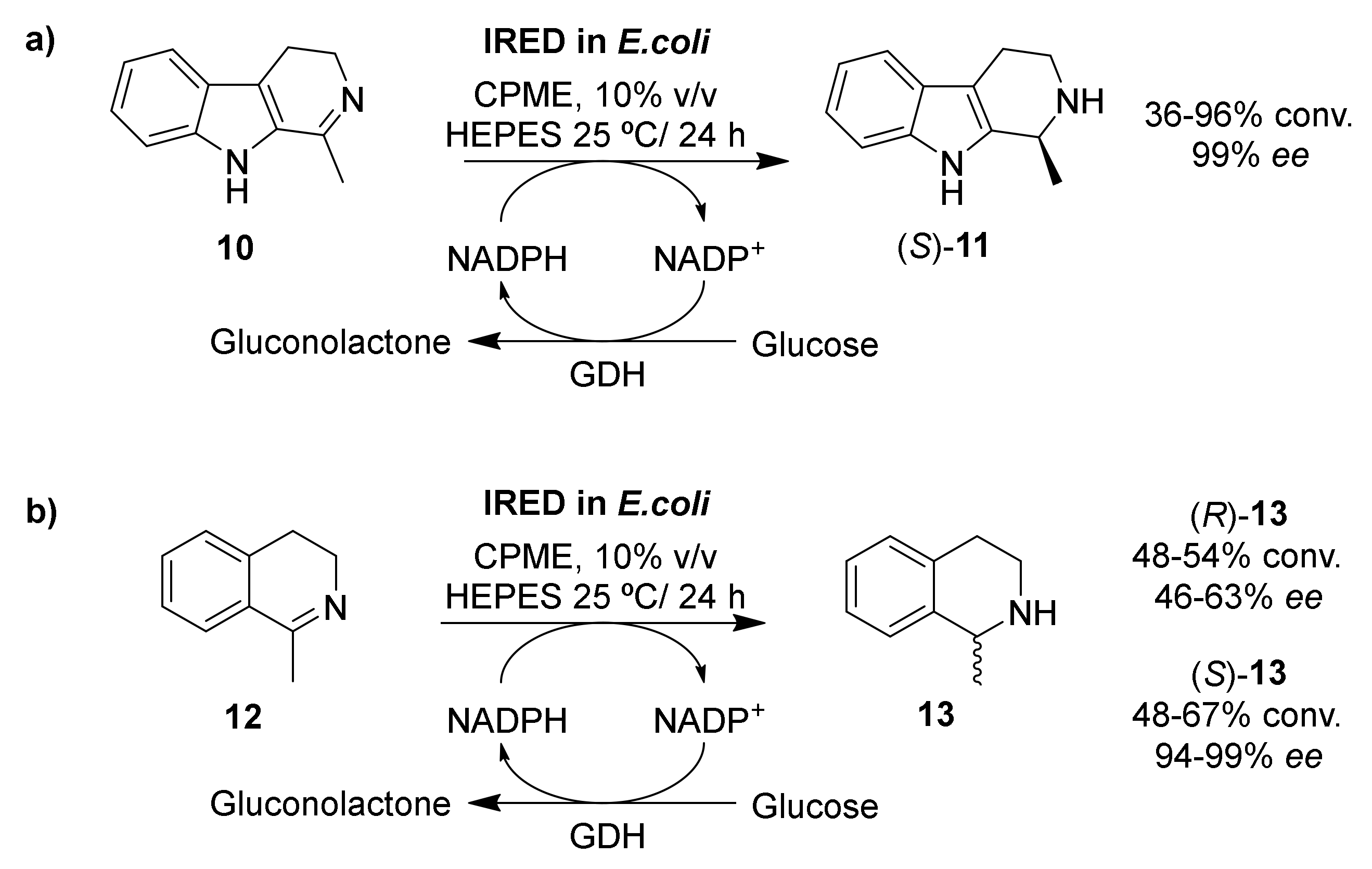


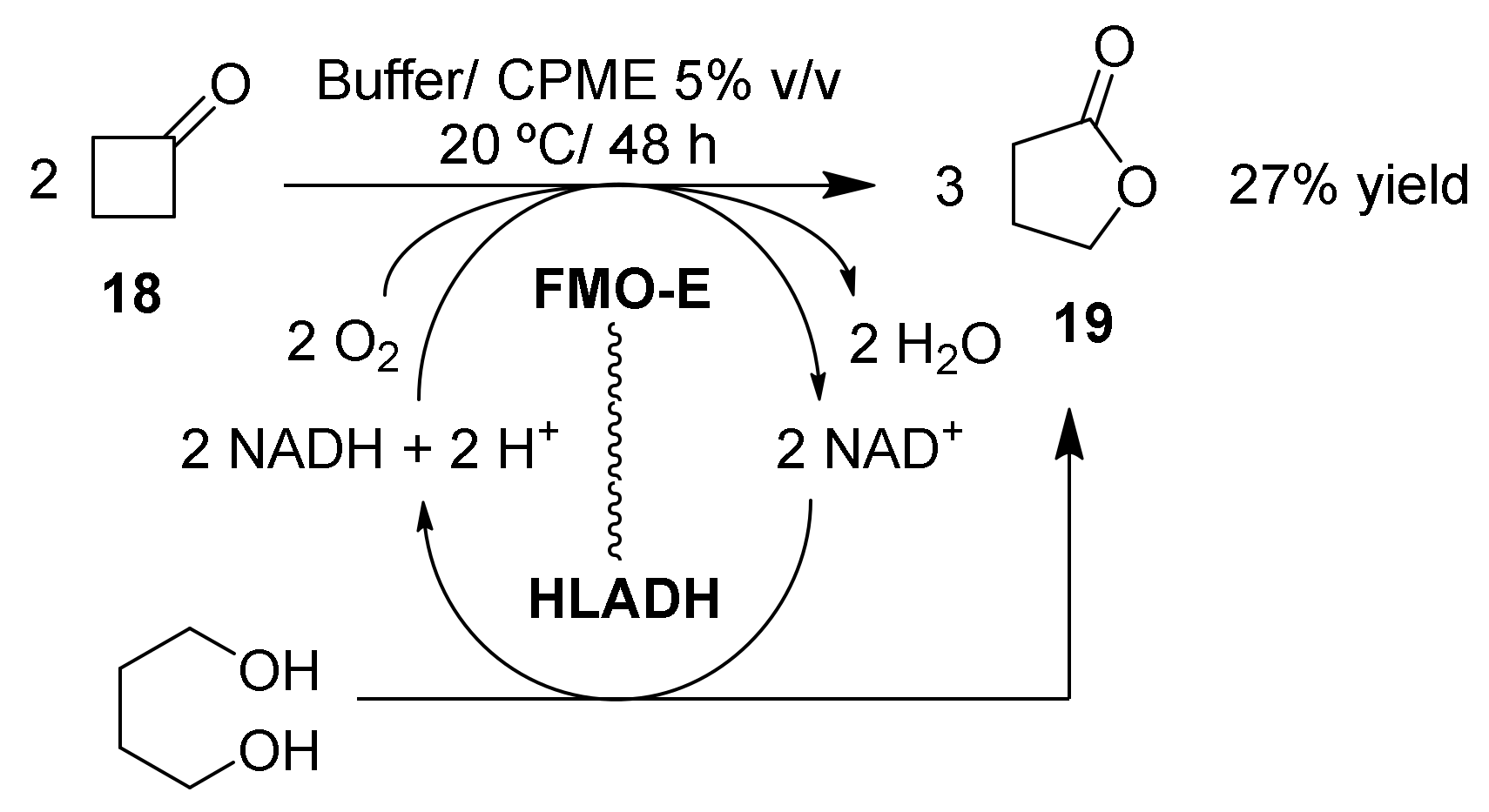


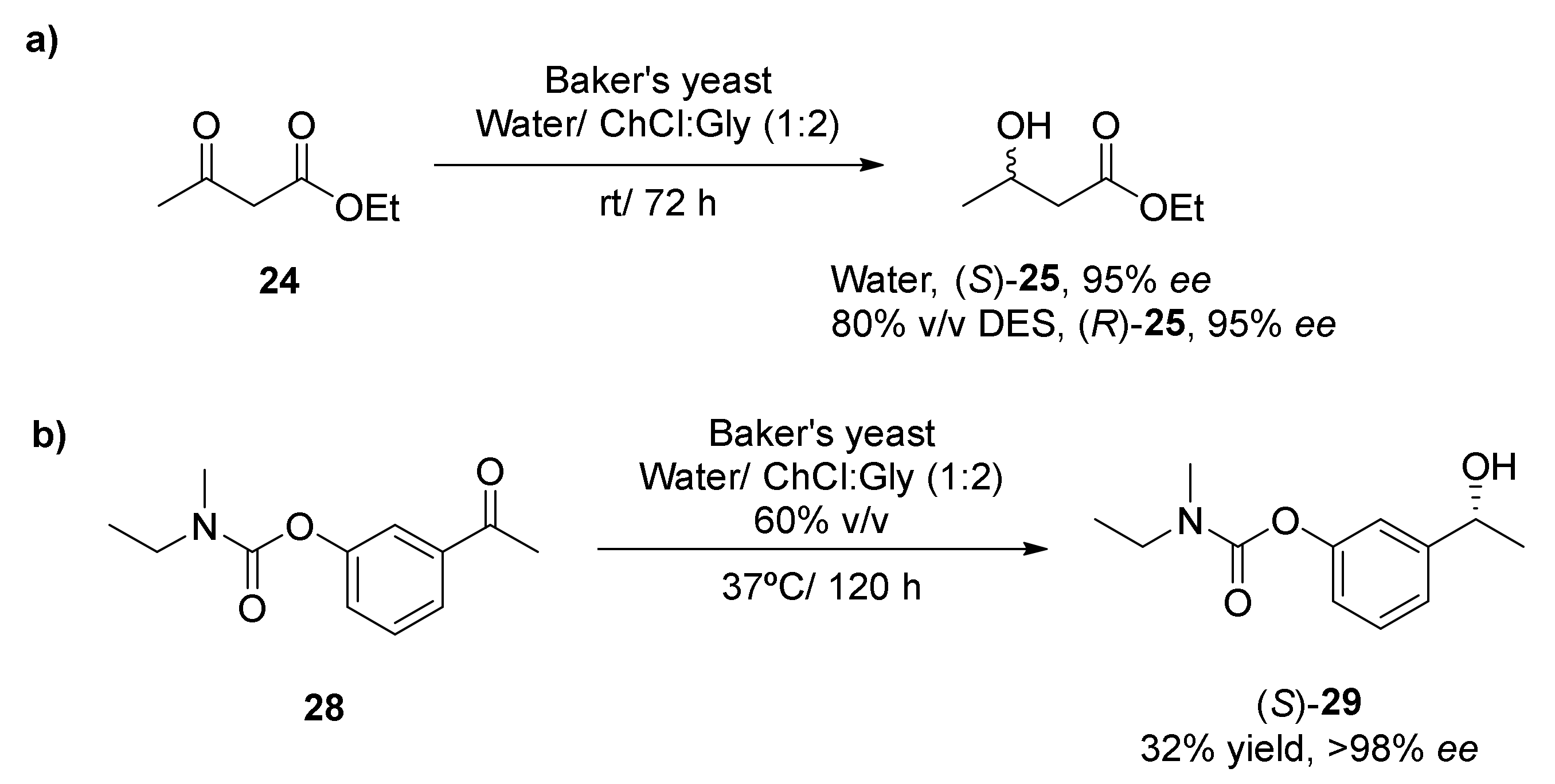


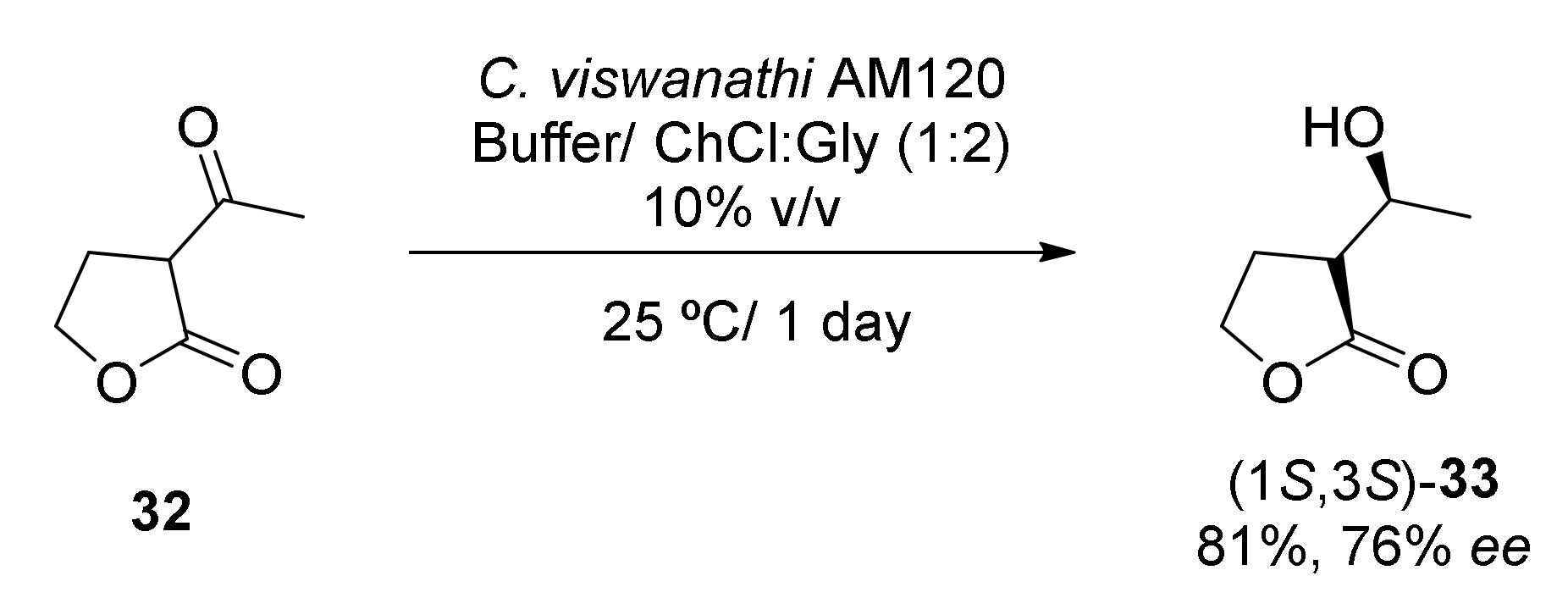
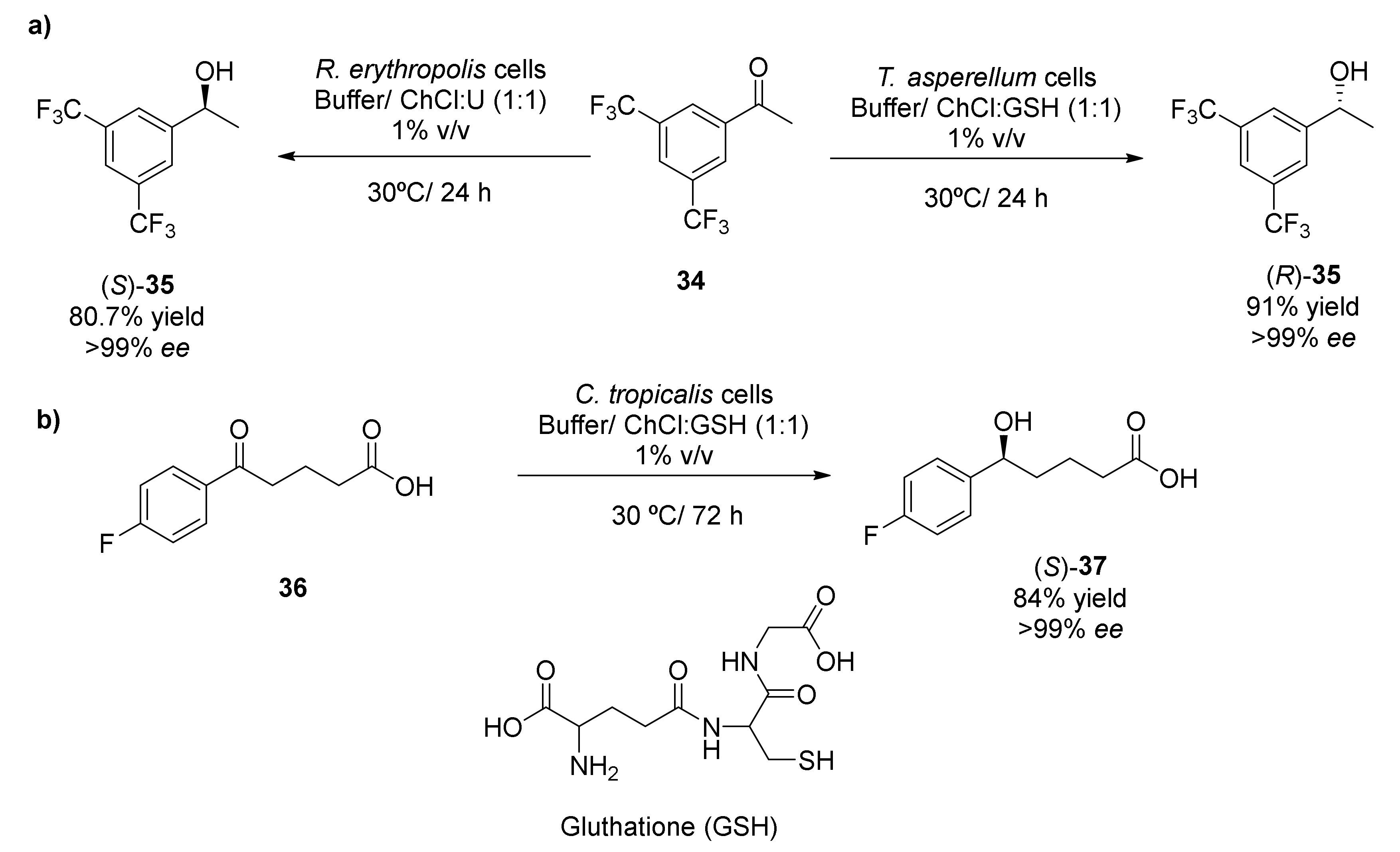



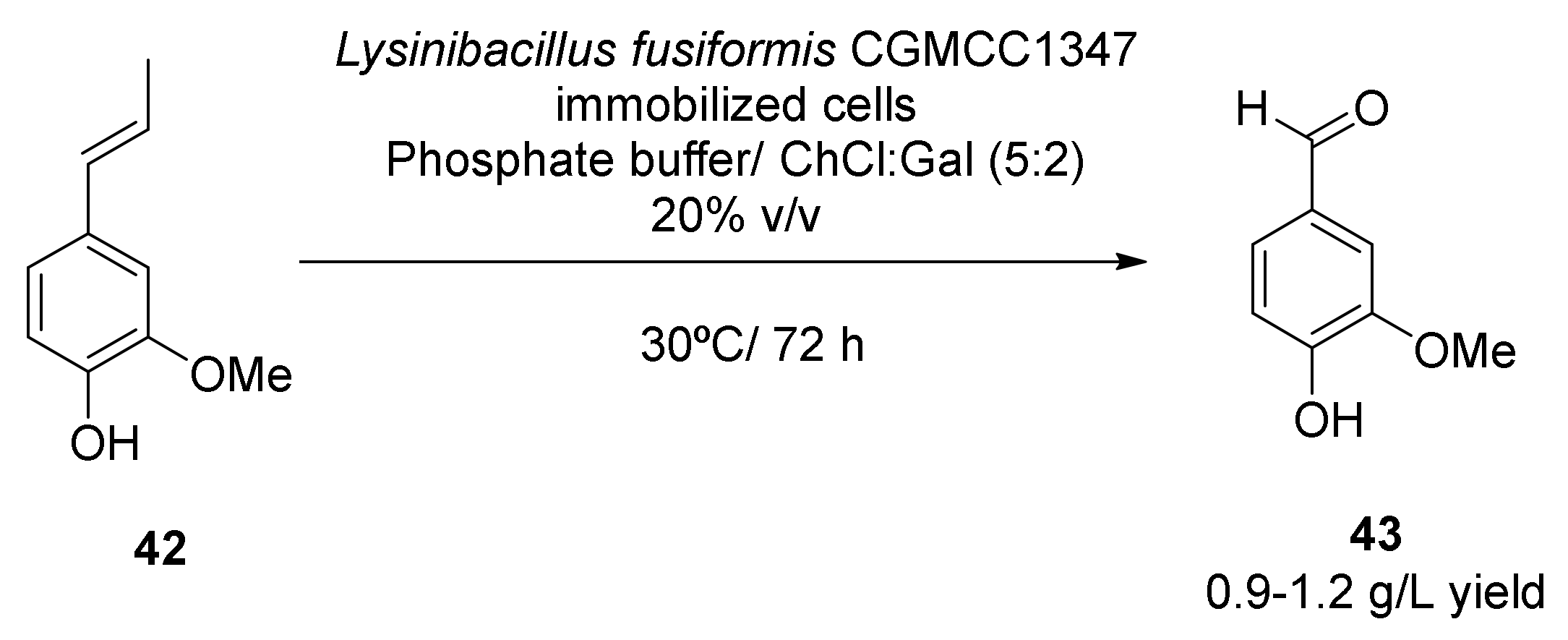



| Biocatalyst | Solvent (% v/v) | Yield (%) | ee (%) | Reference |
|---|---|---|---|---|
| Enoate reductases | CPME 20% v/v | <10 | 0–99 | [53] |
| Imine reductases | CPME 90% v/v | 36–96 | 46–99 | [58] |
| ADH | CPME 10% v/v | >90 | >90 | [59] |
| ADH | CPME 5% v/v | 99 | 99 | [60] |
| Monooxygenase + ADH | CPME 5% v/v | 27 | - | [61] |
| Alcohol and glycerol dehydrogenases | 2-MeTHF 5% v/v | 75–99 | >99 | [64] |
| Saccharomyces cerevisiae YOL151W Reductase | 2-MeTHF 3% v/v | 99 | >99 | [65] |

| Entry | Solvent | Time (days) | Yield (%) | ee (%) | Config. |
|---|---|---|---|---|---|
| 1 | Water | 1 | 88 | 96 | S |
| 2 | Water + ChCl:Fru (3:2) 60% v/v | 5 | 31 | 78 | S |
| 3 | Water + ChCl:Fru (3:2) 90% v/v | 5 | 14 | 60 | R |
| 4 | Water + ChCl:Gly (1:2) 50% v/v | 6 | 88 | 88 | S |
| 5 | Water + ChCl:Gly (1:2) 80% v/v | 6 | 44 | 60 | R |
| 6 | Water + ChCl:Gly (1:2) 90% v/v | 6 | 36 | 96 | R |
| Product | ADH | NADES (% v/v) | Yield (%) | ee (%) | Ref. |
|---|---|---|---|---|---|
| (S)-1-phenylethanol | Ralstonia sp. E. coli cells | ChCl:Gly (1:2) 80% v/v | 90 (a) | 98 | [79] |
| (S)-1-phenyl-1-propanol | Ralstonia sp. E. coli cells | ChCl:Gly (1:2) 80% v/v | 90 (a) | 82 | [79] |
| (R)-2-octanol | Acetobacter pasteurianus GIM1.158 cells | ChCl:EG (1:1) 10% v/v | 96 | 99 | [80] |
| (S)-4-chloro-3-hydroxybutanoate | E. coli CCZU-T15 cells | ChCl:Gly (1:2) 12.5% v/v | 93 | >99 | [81] |
| (1S,3S)-α’-1-hydroxyethyl-γ-butyrolactone | Candida viswanathi AM120 cells | ChCl:Gly (1:2) 10% v/v | 81 | 76 | [82] |
| (R)-1-phenyl-1,2-ethanodiol | Kurthia gibsonii SC0312 cells | ChCl:BD (1:4) 2% v/v | 80 | >99 | [83] |
| (S)-3,5-bistrifluoromethyl- phenyl ethanol | Rhodococcus erythropolis XS1012 cells | ChCl:U (1:1) 1% w/v | 81 | >99 | [84] |
| (R)-3,5-bistrifluoromethyl- phenyl ethanol | Trichoderma asperellum ZJPH0810 cells | ChCl/GSH (1:1) 1% v/v | 91 | >99 | [85] |
| (S)- (3,4-dimethylphenyl)ethanol | Carrot roots cells | ChCl:Gly (1:2) 20% v/v | 50 | 83 | [86] |
| (S)-2-octanol | Lyophilized ADH-T | ChCl:Glu (1.5:1) 10% v/v | 85 | >99 | [87] |
| (R)-1-phenyl-1-propanol | KRED P1-A04 | ChCl:Gly (1:2) 50% v/v | 95 | >99 | [88] |
| (S)-1-(4-bromophenyl)-1-propanol | KRED P2-H07 | ChCl:Gly (1:2) 50% v/v | 90 | >99 | [88] |
| Biocatalyst | NADES (% v/v) | Reference |
|---|---|---|
| Acetobacter sp. CCTCC M209061 immobilized cells | ChCl:Gly (1:2) 10% v/v | [89] |
| Lysinibacillus fusiformis CGMCC1347 cells | ChCl:Gal (5:2) 20% v/v | [90] |
| HMFO from Methylophaga sp | Glu:Fru:H2O (1:1:5) 60–80% v/v | [93] |
| Novozym 435 + ChOx from Arthrobacter nicotinae | ChCl:Pro:H2O (1:1:1) 25–75% v/v | [95] |
| rAaeUPO + ChOx from Arthrobacter nicotinae | ChCl:U:Gly (1:1:1) 25% v/v | [96] |
| rAaeUPO + ChOx from Arthrobacter nicotinae | ChCl:U (1:1) 50% v/v | [97] |
© 2020 by the authors. Licensee MDPI, Basel, Switzerland. This article is an open access article distributed under the terms and conditions of the Creative Commons Attribution (CC BY) license (http://creativecommons.org/licenses/by/4.0/).
Share and Cite
Aranda, C.; de Gonzalo, G. Biocatalyzed Redox Processes Employing Green Reaction Media. Molecules 2020, 25, 3016. https://doi.org/10.3390/molecules25133016
Aranda C, de Gonzalo G. Biocatalyzed Redox Processes Employing Green Reaction Media. Molecules. 2020; 25(13):3016. https://doi.org/10.3390/molecules25133016
Chicago/Turabian StyleAranda, Carmen, and Gonzalo de Gonzalo. 2020. "Biocatalyzed Redox Processes Employing Green Reaction Media" Molecules 25, no. 13: 3016. https://doi.org/10.3390/molecules25133016






